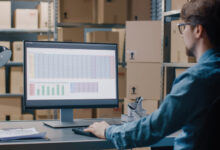Conducting Warehouse Automation Feasibility as Distribution Logistics Enters a New Era

Today’s businesses are facing a battle like never before due to rising customer expectations and increased operational disruptions. Companies must now compete with their competitors based on cost and service level metrics and allocate capital resources in the most appropriate way to achieve the required agility. How a business views and manages its distribution network and the logistics resources that make up this network has a tremendous impact on outcomes and must align with defined strategic objectives.
The acceleration in e-commerce is changing the way companies do business, while innovative companies entering the sector are intensifying competition. Legacy distribution networks are being called upon to enhance their capabilities, and warehouse operations are being redesigned. Supply chain managers, finding themselves at the table with company executives and top management, are expected to find solutions to increase their share in the e-commerce market by battling against Amazon, other emerging e-commerce start-ups, and traditional large firms.
“Companies should not answer the question of ‘what is a warehouse automation system’ as a ‘quick fix’ tool, but rather make decisions about warehouse automation systems by measuring their strategic and financial impacts.”

When conducting a feasibility study for warehouse automation, consider the following:
- Define your business needs: While you may initially think there’s nothing new, expressing the needs of the market, customers, and therefore your business clearly requires serious effort. How will you meet these needs with a warehouse automation system? What is the cost of warehouse automation investment and how can it translate into financial benefits?
- Identify stakeholders: Identify all stakeholders who will approve the warehouse automation investment and benefit from it. Ensure that stakeholders are involved in the decision-making process early and focus on their investment impacts. Learn from past decision-making processes of other major investments.
- Speak the same language: Speak the same language as stakeholders at all levels of the organizational hierarchy. Make sure you explain the operational and financial returns of warehouse automation investment with the right metrics.
- Eat yogurt by blowing: Before embarking on a large-scale investment to be used either widely in a single warehouse or as a point application repeated in multiple warehouses, test the results by conducting a pilot project.
- Remember that successful results take time: Your board of directors is evaluating many other investment projects in addition to yours. In this context, investments in the supply chain generally have high financial costs and relatively long payback periods. Make sure that all stakeholders at both upper and lower levels understand this. The business may begin to see the significant impact of warehouse automation systems two or three years later. The longer you wait to start, the further behind the competition you’ll fall.
- Utilize simulation: Many unexpected problems can arise during the implementation of an automation idea for a material handling system. Since the dynamic behavior of a material handling system cannot be tested before it is installed, high-cost problems arise during the commissioning phase. By simulating, you complete all control and testing of your material handling system investment during the design phase and verify the idea. Your vision for material handling automation can be simulated under the dynamic conditions and operational load of your warehouse even before the system is installed.
An investment in warehouse automation not only promises savings in labor costs but also provides the ability to provide the service your customers expect today and in the future, thereby increasing your brand value.
Dijitalis Solution
When deciding to invest in smart automation technologies, you will encounter many options. Each will have different advantages and disadvantages, and each will have a different return on investment. Therefore, you must be sure that the technology you are investing in answers both today’s and tomorrow’s questions. Dijitalis supports its customers in choosing the right automation concept – from analysis to conceptual design, from supplier selection to commissioning control.
When you want to invest in smart and automatic material handling systems, you will discover that there are many equipment options, each with different advantages and limitations. When the conflicting experiences and ideas of project stakeholders such as your own engineers, equipment manufacturers, and system integrators are added to this complexity, deciding what the “best solution” is becomes very difficult. As an impartial consultancy firm, Dijitalis works independently of equipment and automation companies.
- Designing warehouse automation projects correctly, integrating engineering disciplines such as mechanical, automation, and ergonomics into the design process,
- Identifying and supporting suppliers to implement projects related to material handling systems,
- Providing management support from start to finish by providing commissioning services for material handling automation projects.





